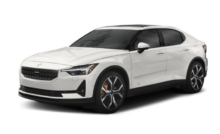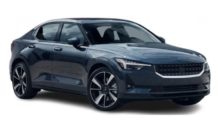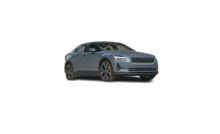Braking on salted roads
This could increase stopping distance. Maintain an extra-large safety distance to the vehicle ahead. Make sure to also:
- Apply the brakes from time to time to help remove the salt. Make sure braking does not pose a risk to any other road users.
- Gently apply the brakes when you have finished driving and before driving again.
Braking on wet roads
This may also occur after washing the vehicle. It will then be necessary to apply greater pressure to the brake pedal. You should therefore maintain a greater distance to the vehicle ahead.
Firmly apply the brakes after washing the vehicle or driving on wet roads. This helps warm up the brake discs, enabling them to dry more quickly and protecting them against corrosion. Consider the current traffic situation when braking.
Driving through standing water
To help prevent damage to the vehicle when driving through water:
- Do not drive in water higher than the floor of the vehicle. If possible, check the depth of the water at its deepest point before driving through it. Be particularly careful when driving through flowing water.
- Do not drive faster than walking speed.
- Do not stop the vehicle in the water. Drive carefully forward or back the vehicle out of the water.
- Remember that waves created by passing vehicles could cause the water level to rise above the vehicle’s floor level.
- Avoid driving through salt water to help avoid the risk of corrosion.
Because it can be difficult to determine the water depth, Polestar recommends not driving through standing or running water. The driver is always responsible for operating the vehicle in a safe manner and adhering to all applicable laws and regulations.
When you have passed the water, press lightly on the brake pedal and check that the brakes are functioning properly. Water, mud, slush, etc. can make the brake linings slippery, resulting in a delayed braking effect.
Economical driving
Before driving
- Whenever possible, precondition the vehicle before driving by connecting the charging cable to an electrical outlet.
- If preconditioning is not possible when it is cold outside, use seat and steering wheel heating first. Avoid heating the entire passenger compartment to reduce the amount of current being taken from the battery.
- The type of tires and inflation pressure used could affect energy consumption – consult Polestar Customer Support for advice on suitable tires.
- Remove unnecessary items from the vehicle – the heavier the load, the higher the energy consumption.
While driving
- Maintain a steady speed and a generous following distance to traffic ahead to minimize braking.
- When braking, the battery is charged by:
- braking lightly using the brake pedal.
- releasing the accelerator pedal and making sure that regenerative braking recovery is set to Standard.
- Higher speeds increase energy consumption because air resistance increases with speed.
- In a cold climate, reduce heating of the windshield/rear window, mirrors, seats, and the steering wheel.
- Avoid driving with the windows open.
- Do not use the accelerator pedal to keep the vehicle stationary on an uphill gradient. Instead, activate the braking function at a standstill.
- If possible, turn off the climate system when driving shorter distances after preconditioning.
After driving
- If possible, park in a climate-controlled garage with vehicle charging outlets or stations.
Parking on a hill
If the vehicle is pointing uphill:
- Turn the front wheels so they are pointing away from the curb.
If the vehicle is pointing downhill:
- Turn the front wheels so they are pointing toward the curb.
Preparing for a long trip
Check that
- the brake pedal is functioning properly
- tire tread depth and air pressure are at the correct levels. Change to snow tires when driving in areas where there is a risk of snowy or icy roads
- The battery is sufficiently charged
- the wiper blades are in good condition
Range
The certified value for the distance that can be driven should not be considered an expected driving range. The certified value should primarily be used to compare the results of different vehicles obtained in special test cycles.
Range in the instrument panel
When the vehicle leaves the factory, or after a factory reset, the range is based on the certified value
After the vehicle has been driven for a period of time, the range will be based on historic driving patterns. The amount of history used depends on the battery’s level of charge. The range, therefore, adapts more quickly to changing driving patterns the less charge there is in the battery.
Factors affecting driving range
In addition to historical trip data, there are several other factors that affect range. The longest range is achieved under very favorable conditions when all factors positively influence the range.
Examples of factors that affect range:
- speed
- climate control settings
- topography
- preconditioning
- tires and tire pressure
- the current traffic situation
- temperature and weather
- road conditions.
Range in cold temperatures
In cold ambient temperatures, the battery may become cold, which will adversely affect the range. If the battery drops to that temperature, this symbol will be shown on the instrument panel. If the vehicle is parked in cold ambient temperatures, the range could be drastically reduced. To avoid extremely reduced range after parking in cold ambient temperatures, the vehicle should be charged while it is parked.
Range-based on speed and ambient temperature
- 20 °C (68 °F) ambient temperature and passenger compartment climate control off.
- 20 °C (68 °F) ambient temperature and passenger compartment climate control on.
- 35 °C (95 °F) ambient temperature and passenger compartment climate control on.
- -10 °C (14 °F) ambient temperature and passenger compartment climate control on.
The graph shows the approximate relationship between constant speed and driving range. Driving at a lower constant speed helps increase the electric motor’s driving range.
Higher ambient temperature and deactivated climate systems are also more favorable for range.
Range assistant
To help guide drivers in their driving, real-time information is provided on the impact of each energy consumption factor on the range. If speed, driving style, or climate settings are adjusted, the estimated range is updated.
ECO climate can also be activated or deactivated in the range assistant.
- Tap.
- Select Range assistant.
- Activate or deactivate Eco climate.
Winter driving
Before the cold season arrives:
- Check the condition and charge level of the battery. Cold weather places greater demands on the battery and reduces its capacity.
- Use washer fluid containing antifreeze to help prevent ice from forming in the washer fluid reservoir.
Slippery driving conditionsPolestar recommends changing the setting for the one-pedal drive to Offor Low to contribute to more stable driving in slippery or icy conditions.
To help optimize traction and road-holding, Polestar recommends using snow tires on all wheels whenever there is a risk of snow or ice on the road.
Certain countries require the use of winter tires by law. Not all countries permit the use of studded tires.
Practice driving on slippery surfaces under controlled conditions to learn how the vehicle reacts.






